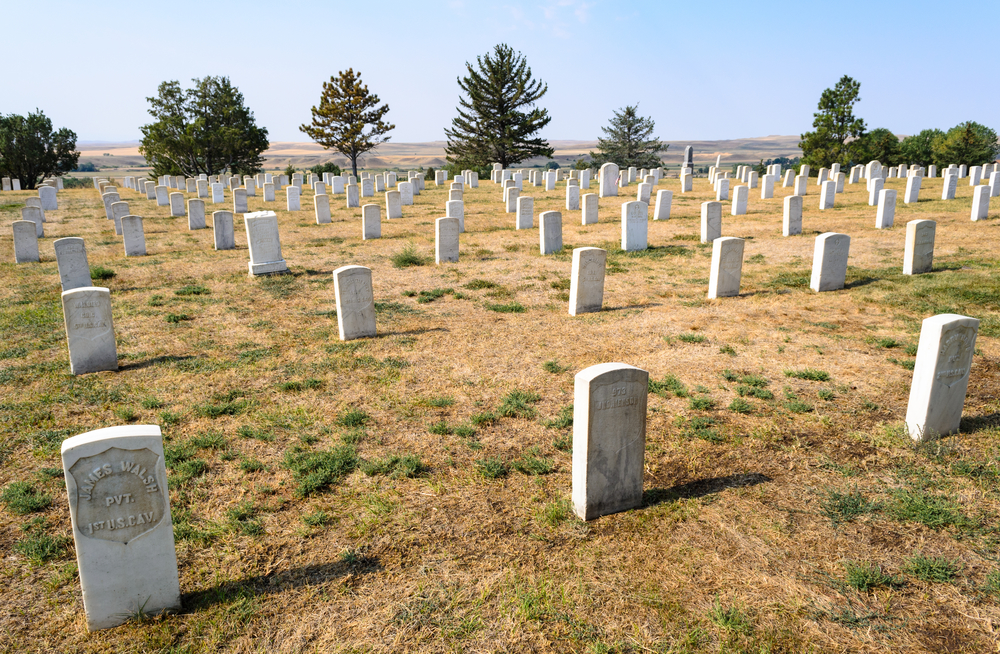Little Bighorn Battlefield National Monument preserves the site of the June 1876 battle between the 7th Cavalry of the US Army led by Lt. Col. George A. Custer and the Lakota and Cheyenne Indians, commonly referred to as Custer’s Last Stand.

Location: Little Bighorn Battlefield National Monument is located in southeastern Montana, near the town of Crow Agency. The site is approximately 60 miles southeast of Billings and offers a profound insight into one of the most famous battles in American history.
History: The site was designated a national monument on March 29, 1879, and was later renamed Little Bighorn Battlefield National Monument in 1991. The monument commemorates the Battle of the Little Bighorn, which took place on June 25-26, 1876. This battle, often referred to as Custer’s Last Stand, was a clash between the United States Army’s 7th Cavalry, led by Lieutenant Colonel George A. Custer, and the combined forces of the Lakota Sioux, Northern Cheyenne, and Arapaho tribes, led by prominent leaders such as Sitting Bull and Crazy Horse.
Why It’s Protected: Little Bighorn Battlefield National Monument is protected for its historical and cultural significance. The site serves as a solemn reminder of the conflict between the U.S. government and the Native American tribes defending their land and way of life. The monument preserves the battlefield, the Custer National Cemetery, and other significant landmarks, ensuring that this pivotal moment in American history is remembered and honored. By protecting the site, we can reflect on the complexities of the past and gain a deeper understanding of the diverse perspectives involved in this historic event.
Things to Do: Visitors to Little Bighorn Battlefield National Monument can engage in various activities that provide a deeper appreciation of the site’s historical importance. Here are some highlights:
- Visitor Center and Museum: Start your visit at the visitor center, where you can explore exhibits, artifacts, and informative displays about the battle and the cultural history of the area. The museum also features a 25-minute orientation film that provides an overview of the events leading up to the battle.
- Ranger Programs: Join ranger-led tours and presentations to gain insights into the battle, the participants, and the broader historical context. These programs offer a detailed and engaging way to learn about the significance of the site.
- Custer National Cemetery: Pay your respects at the Custer National Cemetery, where soldiers from various conflicts, including the Indian Wars, are interred. The cemetery’s serene setting provides a place for reflection and remembrance.
- Self-Guided Tours: Explore the battlefield at your own pace with a self-guided tour. Interpretive markers and signs are placed throughout the site, providing information about key locations and events during the battle.
- Deep Ravine Trail: Take a walk along the Deep Ravine Trail, a short interpretive trail that leads to the spot where many of the 7th Cavalry soldiers made their last stand. The trail offers a poignant perspective on the battlefield and the experiences of those who fought there.
- Photography: Capture the sweeping landscapes and historical landmarks of the battlefield. The site’s open vistas and natural beauty make for striking photographs that convey the solemnity and significance of the location.
Little Bighorn Battlefield National Monument is a place of profound historical and cultural importance. Its preservation allows visitors to honor the memory of those who fought and to reflect on the broader narratives of American history. Whether you’re a history enthusiast or a curious traveler, a visit to this monument offers a powerful and educational experience.
Agate Fossil Beds
Aztec Ruins
Bandelier
Bears Ears
Cabrillo
Canyon de Chelly
Cedar Breaks
Colorado
Devils Postpile
Devils Tower
Dinosaur
Effigy Mounds
El Malpais
Florissant Fossil Beds
Fort McHenry
Fort Moultrie
Fort Pulaski
Fort Stanwix
Fort Sumter
George Washington Birthplace
Gila Cliff Dwellings
Grand Staircase-Escalante
Hovenweep
Lava Beds
Little Bighorn Battlefield
Misty Fjords
Montezuma Castle
Muir Woods
Natural Bridges
Ocmulgee
Organ Pipe Cactus
Pipestone
Pompeys Pillar
Rainbow Bridge
Russell Cave
Salinas Pueblo Missions
Scotts Bluff
Statue of Liberty
Sunset Crater Volcano
Tuzigoot
Vermilion Cliffs
White Sands
World War II Valor in the Pacific
Wupatki
